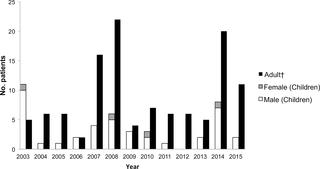PLOS Neglected Tropical Diseases ( IF 3.4 ) Pub Date : 2018-03-08 , DOI: 10.1371/journal.pntd.0006294 Kouki Tomari , Takao Toyokawa , Takuto Takahashi , Tetsuya Kakita , Sho Okano , Hisako Kyan , Naoya Tonegawa , Teppei Okawa , Takashi Matsuoka , Tsutomu Matsumora

|
Leptospirosis is considered underdiagnosed because of its nonspecific presentation and lack of proper understanding of its epidemiology. Early diagnosis and treatment are crucial. However, few data are available on confirmed leptospirosis cases in children in industrialized countries. We therefore aimed to describe epidemiologic and clinical characteristics of laboratory-confirmed childhood leptospirosis in Okinawa, Japan. We reviewed the national surveillance data of pediatric leptospirosis in Okinawa, Japan from January 2003 through December 2015. The database included all of laboratory-confirmed leptospirosis diagnosed at the only central laboratory for leptospirosis in the region. There were 44 children (0–20 years of age) with laboratory-confirmed leptospirosis. Of these, 90% were male, 91% were 10–20 years of age, and 96% of cases occurred in August and September. The number of laboratory-confirmed patients ranged from 0 to 11 per year (mean: 3.3 per year), and the estimated annual rate was 1.0 per 100,000 pediatric populations. In all cases, the presumed infection route was recreational exposure to river water. Commonly observed manifestations include fever (95%), myalgia (52%), and conjunctival suffusion (52%). Childhood leptospirosis in Okinawa, Japan occurred predominantly in teenage boys after freshwater exposure in summer, and most patients had characteristic conjunctival suffusion. Cohort studies would be helpful to better understand more detailed clinical manifestations in association with prognosis.
中文翻译:

工业化国家的儿童钩端螺旋体病:日本冲绳县基于人群的研究
由于钩端螺旋体病呈非特异性表现且缺乏对流行病学的正确理解,因此被认为诊断不足。早期诊断和治疗至关重要。但是,关于工业化国家儿童确诊的钩端螺旋体感染病例的数据很少。因此,我们旨在描述日本冲绳县经实验室确认的儿童钩端螺旋体病的流行病学和临床特征。我们回顾了2003年1月至2015年12月日本冲绳县的小儿钩端螺旋体病国家监测数据。该数据库包括所有在该地区唯一的钩端螺旋体病中央实验室诊断出的实验室确诊的钩端螺旋体病。有44名儿童(0至20岁)患有实验室确诊的钩端螺旋体病。其中,90%是男性,91%是10–20岁,96%的病例发生在8月和9月。经实验室确诊的患者人数每年为0到11名(平均:每年3.3名),估计的年发病率为每100,000名儿童中有1.0名。在所有情况下,假定的感染途径都是娱乐性地暴露于河水中。常见的表现包括发烧(95%),肌痛(52%)和结膜积液(52%)。在日本冲绳,童年钩端螺旋体病主要发生在夏季淡水接触后的十几岁男孩中,大多数患者具有特征性结膜渗出。队列研究将有助于更好地了解与预后相关的更详细的临床表现。估计的年发病率为每100,000个小儿1.0。在所有情况下,假定的感染途径都是娱乐性地暴露于河水中。常见的表现包括发烧(95%),肌痛(52%)和结膜积液(52%)。在日本冲绳,童年钩端螺旋体病主要发生在夏季淡水接触后的十几岁男孩中,大多数患者具有特征性结膜渗出。队列研究将有助于更好地了解与预后相关的更详细的临床表现。估计的年发病率为每100,000个小儿1.0。在所有情况下,假定的感染途径都是娱乐性地暴露于河水中。常见的表现包括发烧(95%),肌痛(52%)和结膜积液(52%)。在日本冲绳,童年钩端螺旋体病主要发生在夏季淡水接触后的十几岁男孩中,大多数患者具有特征性结膜渗出。队列研究将有助于更好地了解与预后相关的更详细的临床表现。日本主要发生在夏季淡水接触后的十几岁男孩中,大多数患者具有特征性结膜渗出。队列研究将有助于更好地了解与预后相关的更详细的临床表现。日本主要发生在夏季淡水接触后的十几岁男孩中,大多数患者具有特征性结膜渗出。队列研究将有助于更好地了解与预后相关的更详细的临床表现。











































 京公网安备 11010802027423号
京公网安备 11010802027423号